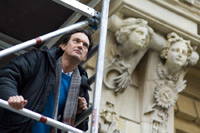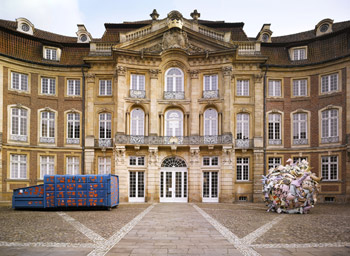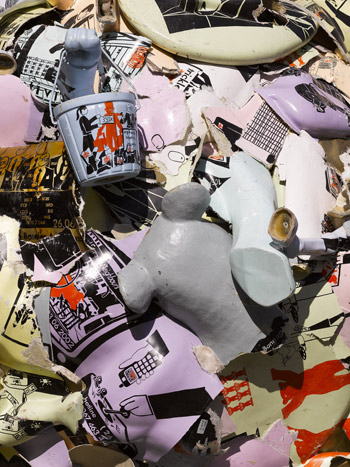news
newsletter
archiv
impressum
PawelAlthamer | MichaelAsher | NairyBaghramian | GuyBen-Ner | GuillaumeBijl | MartinBoyce | Jeremy Deller | MichaelElmgreen und IngarDragset | Hans-PeterFeldmann | DoraGarcia |
IsaGenzken | DominiqueGonzalez-Foerster | TueGreenfort | DavidHammons | ValérieJouve | MikeKelley | Suchan Kinoshita | MarkoLehanka | GustavMetzger | EvaMeyer und EranSchaerf | DeimantasNarkevicius | BruceNauman | MariaPask |
ManfredPernice | SusanPhilipsz | MarthaRosler | ThomasSchütte | AndreasSiekmann | RosemarieTrockel | SilkeWagner | MarkWallinger | Clemens von Wedemeyer | AnnetteWehrmann | PaeWhite

* 1961, Hamm, lebt und arbeitet in Berlin

The most beautiful corner of Münster is round, goes the saying by which locals mean the Erbdrostenhof, a noble’s palace built in the baroque style by the architect Johann Conrad Schlaun. Here, where Richard Serra placed twenty-four tons of steel in 1987, Andreas Siekmann has found the ideal stage for his protest sculpture. As implies the subtitle of the work – Public Space in the Era of Its Privatization – this is no short story. Since 1998, town centers in Germany have been invaded by an army of plastic figures, mostly in the shape of animals and referred to as “urban art” by city marketing specialists. Now present in 600 cities and municipalities in Germany, these plastic figures are supposed to serve as distinctive landmarks and convey a cheerful image. But in truth they are the mute witnesses of a broad economic transformation, as part of which many areas of public life have been sold to private investors. Indeed, urban space has been put up for sale. For skulptur projekte münster 07, Siekmann has taken thirteen of these figures, put them in a compactor, and used the resulting debris to create a large sphere, which he is placing, along with the compactor itself, in front of the Erbdrostenhof. It is biting commentary on the “trickle down” theory of Adam Smith, which holds that great wealth, even if it is concentrated in the hands of a few, can trickle down to lower segments of society, bringing prosperity to all. Translating abstract economic processes into simple pictures is almost impossible, but Siekmann successfully does so with his typified visual language, similar to pictograms. With these images, which cover both the compactor and form a frieze that adorns the inner courtyard, the artist summons the global economic players to the court of art. This work, and Siekmann’s œuvre as a whole, depict power relations that are seldom put on display.
Download Glossary (PDF)

Andreas Siekmann thematisiert in seinen Arbeiten die Ökonomisierung und Privatisierung des öffentlichen Stadtraumes. Die Zeichnungen, Modelle, Videos, Ausstellungsprojekte und Arbeiten im öffentlichen Außenraum stellen herrschende Machtverhältnisse kritisch und ironisch zur Schau und formulieren Gegenentwürfe. Siekmann interessiert sich für den ökonomischen Paradigmenwechsel von sozialer Marktwirtschaft zu Neoliberalismus und für die Auswirkungen der Globalisierung auf die verschiedenen gesellschaftlichen Felder. Für die Skulpturenausstellung „Sonsbeek 93“ in Arnheim entwarf er 1993 den „Platz der permanenten Neugestaltung“, der die verschiedenen potentiellen Nutzer eines öffentlichen Platzes und ihre jeweiligen Partikularinteressen in den Mittelpunkt von sieben fiktiven Platzgestaltungen stellte. Die Funktions- und Beziehungslosigkeit sonstiger herkömmlicher öffentlicher Skulptur wurde damit umso deutlicher. 2004 konzipierte und organisierte er gemeinsam mit Alice Creischer das Ausstellungsprojekt „Ex-Argentina. Schritte zur Flucht vor der Arbeit zum Tun“.